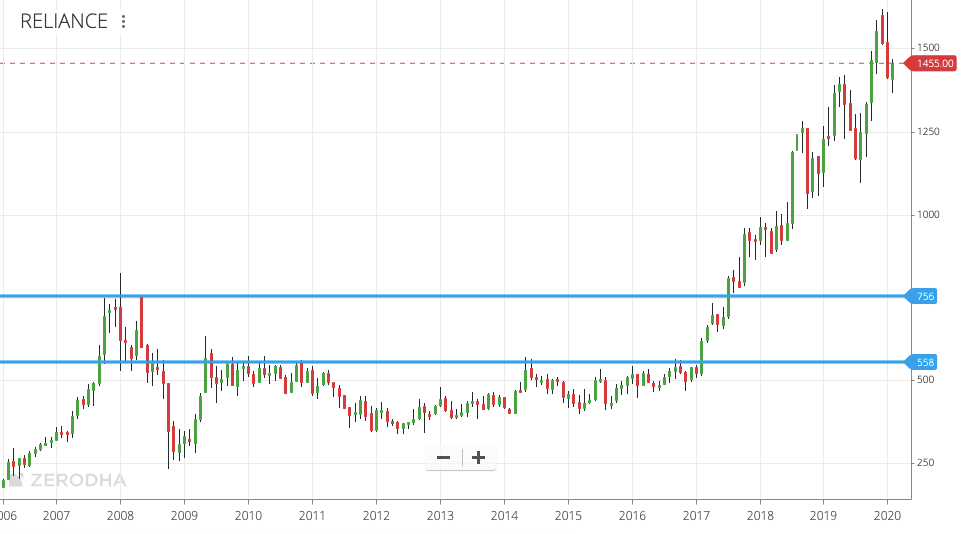Time Frame is the duration of time of a single price bar on a chart. On a 1-minute time frame chart, each candle contains the opening, closing, high and low price of that 1-minute.
The commonly used time frames are:
- 1 minute
- 5 minutes
- 10 minutes
- 15 minutes
- 30 minutes
- 1 hour
- 1 day
- 1 week
- 1 month
There are other time frames like 2 min, 3 min, 4 min, 2 hours, 3 hours, quarterly (3 months) and some trading softwares also provide support for time frame of seconds. But the above mentioned time frames are more common and good enough for most traders.
CandleStick Formation in time frames
On a 1-minute time frame chart, a new candle is formed every minute. If the market opens at 9:15AM, the candle will begin forming at 9:15 until 9:16AM. The open, high, low and closing price between 9:15 to 9:16 will form the 1-minute candle.
On a 5-minute chart, a new candle will be formed every 5 minutes. I.e from 9:15AM to 9:20AM will be one candle, the second candle will be between 9:20 to 9:25 and so on. Each 5-minute candle will contain the open, high, low and closing price (OHLC) of those 5 minutes.
On 60-minute chart (also called hourly chart), a new candle is formed every hour. Each candle contains OHLC of 1 hour.
On a 1-week chart (also called daily chart), the candle forms between market hours i.e 9:15AM to 3:30PM. Each day is one candle and contains OHLC of the entire day.
On a weekly chart (1-week), the candle is formed between Monday to Friday. It’ll contain the OHLC of the week.
On a monthly chart (1-month), the candle is formed between the first day of the month to the last day of the month. The entire month will be compressed into just one candle and contain the OHLC of the entire month.
Best Time frame for Intraday
The best time frame for intraday trading will differ from person to person. Some are more comfortable with 30-minute or hourly charts, while others like the volatility and fast-movement of small time frames like 10 minutes or less.
Many traders believe the shorter time-frames is where money can be made, but it requires experience, expertise, quick decision-making skills and a calm mind to be successful. On 1-minute to 5-minute charts, there’s a lot happening very quickly.
The 30-minute to hourly charts are more calmer in movement and hence can give you more time to decide, plan and execute your trades.
Be aware that intraday is one of the more difficult forms of trading. Very few people go on to become successful intraday traders. Beginners should stay away from intraday and work towards becoming good at longer term trades.
Once you put in those years of learning and know what you are doing, you can look at taking short term or intraday trades.
Best Time Frame for Short Term Trades
Daily charts are a favourite of many traders because it can be used for short term as well as medium term trades.
Daily charts give traders plenty of time to plan their trades. You do not have to look at the chart formation every minute or every hour. You can sit back, relax after market hours and analyse the new candle or the pattern that is forming.
For most traders who avoid intraday and prefer positional short term trades, daily time frame is probably the best.
Best Time Frame for Long Term Trades
The weekly and monthly charts can be used for medium or long term trades (1 month to many years).
A lot of people these days use a combination of fundamental and technical analysis to buy stocks. While fundamental analysis is done to identify stocks to invest in, technical analysis can tell you when to buy and when to sell those stocks.
When stocks breakout on weekly or monthly charts, it can give phenomenal returns even in the long run.
For example, Reliance Industries gave a clear break out on the monthly chart in February 2017. For many years, it was finding resistance at the ₹ 575 price point.
But in Feb 2017, the chart gave a clear break-out signal as the stock rose above its 8-year high and went upto nearly ₹ 630 per share. That was a great buying opportunity, as the breakout on the charts coincided with the launch of Reliance Jio.
In July 2017, the monthly chart gave another major breakout when Reliance went above its all-time high which was created nearly 10 years ago in January 2008. That was another great opportunity to buy, as Jio was gaining market share rapidly.

Since then, Reliance has been unstoppable. Rising to a high of ₹ 1600 per share. A 3x multibagger in just 3 years since the launch of Jio. The company still has a long way to go, as Jio has more than 40 crore customers – which is more than the population of United States of America. Its Retail business is also growing exceptionally well.
The breakouts on monthly charts can give long term opportunities. But stocks that go bearish or move sideways on monthly chart can also be long-time under performers – like Larsen and Toubro, ITC etc.
How to change Chart Time Frame in Zerodha
Time frames can be easily changed in Zerodha. You can watch the video below.
Do notice how the time periods change when you select different time frames. When weekly charts are selected, it shows nearly 2 years of data on one screen as each candle is one week.
Monthly charts can help you identify long term trends, as each candle had data of one month. 12 candles is one year. So on one screen you can see the trend from 2011!
Watch the video.


accidentally ended up in this website while searching to understand piercing pattern. Never seen such a simple yet profound explanation. Truly, you are doing great work.